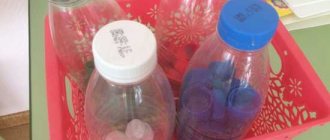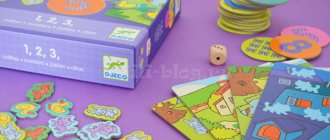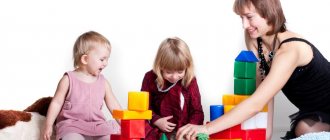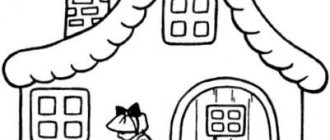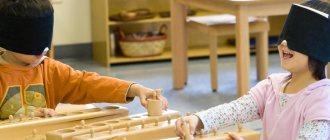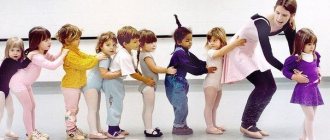Card index of games with numbers and numbers according to REMP for preschoolers
Card index of didactic games with numbers and numbers.
Card No. 1.
Game "Confusion".
Target. Strengthen your knowledge of numbers. Develop observation and attention.
Progress of the game.
In the game, numbers are laid out on the table or displayed on the board. The moment the children close their eyes, the numbers change places. Children find these changes and return the numbers to their places. The presenter comments on the children's actions.
Card No. 2.
The game “Which number is missing?”
Target. Strengthen children's knowledge of numbers and the ability to name neighbors of numbers. Develop memory and attention.
Progress of the game.
The game also removes one or two numbers. Players not only notice the changes, but also say where each number is and why. For example, the number 5 is now between 7 and 8. This is not correct. Its place is between the numbers 4 and 6, because the number 5 is one more than 4, 5 should come after 4.
Map No. 3.
Game "What has changed"
Target. Will strengthen the ability to count objects and indicate their quantity with the corresponding number. Develop attention and memory.
Progress of the game.
Several groups of objects are placed on a board or flannelgraph, with numbers placed next to them. The presenter asks the players to close their eyes, and he himself changes places or removes one item from any group, leaving the numbers unchanged, i.e. violates the correspondence between the number of objects and the number. Children open their eyes. They discovered an error and corrected it in different ways: by “restoring” the number that will correspond to the number of objects, adding or removing objects, i.e. changing the number of objects in groups. The one who works at the board accompanies his actions with an explanation. If he completed the task well (find and correct the error), then he becomes the leader.
Card No. 4.
Game "Wonderful bag".
Target. Exercise children in counting using various analyzers. Strengthen ideas about quantitative relationships between numbers. Develop logic, thinking, attention.
Progress of the game.
The wonderful bag contains: counting material, two or three types of small toys. The presenter chooses one of the children to lead and asks to count as many objects as he hears the blows of a hammer, a tambourine, or as many objects as there are circles on the card. Children sitting at tables count the number of strokes and show the corresponding number.
Map No. 5.
Game "How Much".
Target. Exercise children in counting. Develop hearing and attention.
Progress of the game.
6-8 cards with different numbers of objects are fixed on the board. The presenter says: “Now I’ll tell you a riddle. The one who guesses it will count the items on the card and show the number. Listen to the riddle. The girl is sitting in prison, and her scythe is on the street.” The players, having guessed that it is a carrot, count how many carrots are drawn on the card and show the number 4. Whoever raised the number faster becomes the leader. Instead of riddles, you can give a description of the object. For example: “This animal is affectionate and kind, it does not speak, but knows its name, loves to play with a ball, a ball of thread, drinks milk and lives with people. Who is this? Count how many."
Map No. 6.
Game "Count - don't make a mistake."
Target. Fix the order of numbers in the natural series, practice forward and backward counting. Develop thinking and attention.
Progress of the game.
The game uses a ball. Children sit in a semicircle. Before the start of the game, the presenter agrees in what order (direct or reverse) he will count. The presenter throws the ball to one of the players and calls the number. The one who caught the ball continues to count further. The game should be played at a fast pace, and tasks are repeated many times to give as many children the opportunity to take part in it.
Card No. 7.
The game “The toy that disappeared.”
Target. To consolidate the ordinal counting of objects, the concept of “how many”. Develop attention and memory.
Progress of the game.
The presenter displays several different toys. Children look at them carefully and remember where each toy is. Everyone closes their eyes, the presenter removes one of the toys. Children open their eyes and determine which toy is gone. For example, a car hid, it was third from the right or second from the left. The one who answers correctly and completely becomes the leader.
Card No. 8.
The game “Where is it?”
Target. Keep the score within five. Develop memory and attention.
Progress of the game. Models of fruits or vegetables are displayed. The children are counting them. They name where the tomato or apple was. Children check the correctness of their answers.
Didactic games for learning ordinal and quantitative calculations for older children
Didactic games for learning ordinal and quantitative calculations for older children
"Pick up a toy"
Goal: to practice counting objects by the named number and memorizing it, to learn to find an equal number of toys. Content. V. explains to the children that they will learn to count out as many toys as he says. He calls the children one by one and gives them the task of bringing a certain number of toys and placing them on one table or another. Other children are instructed to check whether the task has been completed correctly, and to do this, count the toys, for example: “Seryozha, bring 3 pyramids and put them on this table. Vitya, check how many pyramids Seryozha brought.” As a result, there are 2 toys on one table, 3 on the second, 4 on the third, and 5 on the fourth. Then the children are asked to count out a certain number of toys and place them on the table where there are the same number of such toys, so that it can be seen that there are equal numbers of them. After completing the task, the child tells what he did. Another child checks whether the task was completed correctly.
“Is it enough?”
Goal: to teach children to see equality and inequality of groups of objects of different sizes, to bring them to the concept that number does not depend on size. Content. V. offers to treat the animals. First he finds out: “Will the bunnies have enough carrots and the squirrels have enough nuts? How to find out? How to check? Children count the toys, compare their numbers, then treat the animals by placing small toys next to large ones. Having identified an equality and inequality in the number of toys in the group, they add the missing item or remove the extra one.
"Which Got Away"
Purpose: To train children in ordinal counting
.
Progress of the game
: Invite the children to build a ladder of 4 steps and put one toy on each step. They agree to count the steps from below. Child
turns away, the adult removes one toy. Turning around, the child must say which toy is missing.
"Errand"
Purpose: To exercise children
in the ability to count objects according to
named number, name the numeral, agreeing
with a noun.
Progress of the game
: The adult names a number familiar to the child.
The child brings the same number
of toys and names them. Then the child names the number and completes the assignment.
adult. An adult needs to make mistakes from time to time, but no more than by 1. For each correctly completed assignment, the player receives a chip.
"At the Poultry Farm"
Goal: to exercise children in counting within limits, to show the independence of the number of objects from the area they occupy. Content. V.: “Today we will go on an excursion to a poultry farm. Chickens and chickens live here. There are 6 hens sitting on the top perch, and 5 chicks on the bottom perch. Compare hens and chickens and determine that there are fewer chickens than hens. “One chicken ran away. What needs to be done to get an equal number of hens and chicks? (You need to find 1 chicken and return it to the chicken). The game repeats itself. V. quietly removes the chicken, the children look for a mother hen for the chicken, etc.
